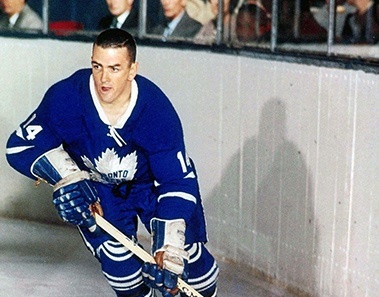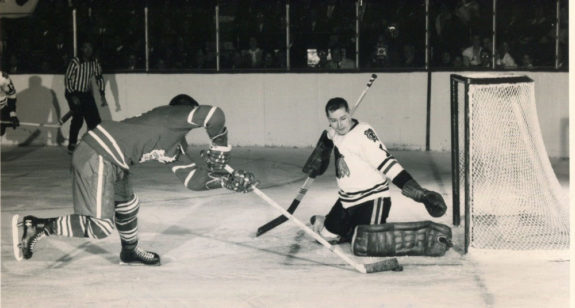On Oct. 16, 2016, as part of the Toronto Maple Leafs’ centennial celebrations, Dave Keon was named the greatest player in the team’s history. In 2017, Keon was also named one of the 100 Greatest NHL Players in NHL history. He was, simply stated, one of the greatest NHL players of all time.
What Dave Keon Did for and With the Maple Leafs
Keon played for the Maple Leafs for 15 NHL seasons (from 1960-61 until 1974-75). During those seasons, he won the Calder Trophy as the NHL’s rookie of the year in 1961, led his team to four Stanley Cups (those were the days), won the Conn Smythe Trophy in 1967 (the team’s last Stanley Cup season), and won two Lady Byng Trophies.

Keon was widely considered to be the best penalty-killer in hockey during the time that he played. The fact that he was then the NHL’s fastest skater and a voracious checker helped. He also could score and topped the NHL in shorthanded goals for two seasons (in 1968-69 with six, and in 1970-71 with eight).
Related: Remembering Borje Salming: “King” of Maple Leafs’ Defensemen
The Conn Smythe Trophy Keon won in 1967 was the first and only anyone on the Maple Leafs ever won. He also was third in all-time scoring for the Maple Leafs, behind Mats Sundin and Darryl Sittler, with 365 goals and 493 assists (for 858 points) in 1062 games.
There’s So Much to Write About Dave Keon, So Just One Little Story
There’s so much to write about Keon that I chose one short story that took place long before Keon ever hit the NHL. What I found interesting within the story were so many little insights about how very different hockey was 70 years ago than it is today.
In my research for another Maple Leafs’ post, I came across an article written about Keon when he was just in his third season with the Maple Leafs. (from “Why Dave Keon is the “best” player in hockey,” Peter N. Allison, MacLeans, 23/03/1963).
Keon grew up in Rouyn-Noranda, Quebec. In 1954, when Keon was 14 years old, he started to be noticed and was invited to a hockey school sponsored by the Detroit Red Wings that would be held in Burlington, Ontario.
Keon Was Offered a Spot with the Junior Detroit Red Wings
Because he obviously impressed those who saw him play, he was asked to stay there to play Junior B hockey. However, when he went home to talk it over with his mother, Keon noted that “my mother said I could pack my own bags if I wanted to go.”
Related: Book Review: Dave Bidini and his search for the lost soul of the Leafs
He chose to stay home, where he played for a juvenile team in Noranda. Eventually, scouts for the Maple Leafs heard about him; and, “under hockey’s peculiar group-slavery system” (a phrase used in the 1963 MacLeans article) the Maple Leafs bought the rights to the entire juvenile team for $1,000.
As a Teenager, Keon Became Too Big for His Britches and Failed
Toronto then made Keon’s parents an offer they couldn’t resist. They offered Keon (as they had his cousin before him Tod Sloan) a scholarship to St. Michael’s College in Toronto. Keon shone at St. Mike’s. He once scored seven goals in a single Junior-B game. He also became a bit of a cocky teenager.
Keon’s success was almost halted, and his arrogance about his natural skills almost became his downfall. Keon bragged that he’d score 40 goals during his third year in juniors. In addition to being cocky, Keon was also quick-tempered.
Keon admitted that, “I got a lot of penalties, including some misconducts.” He started to slump and only was able to score 23 goals, when he had bragged he would hit 40. He became depressed and began to think he would never be able to make the NHL.
The Priests and His Coach at St. Mike’s Gave Keon Solid Advice
At his lowest point, the priests at St. Mike’s and his coach, Bob Goldham, gave him some advice. He needed to become more than a scorer. He needed to play a 200-foot game and become a better checker.
Later, Keon noted “In a way, that depressing year was the best thing that had happened to me. I learned I didn’t have to just throw my stick on the ice to win hockey games. I realized I’d have to learn to check and check properly if I was going to become a pro.”
Related: One for the Ages: Dave Keon’s 1979-80 NHL Season
Then Keon did something about it. As he noted, “All that summer, I thought about checking all the time. I’d be reading a book or watching TV and suddenly I’d find myself thinking about how to play a man. It’s only a matter of starting and stopping. Either I was going to do that extra work or I was going to go for the big skate. I decided to do the extra work.”
Keon Made the Maple Leafs Roster at 20 Years of Age
When he was 20 years old, Keon made the Maple Leafs roster. His hard work learning how to play the man became a part of his skill set. He was every bit as good defensively as he was offensively. He considered every aspect of his play.
He also brought a common-sense approach to hockey. When asked why he’d never been in an NHL fight, which at that time was a fighting league, his answer was “Why should I?”

He added, “It’s hard enough playing seventy games a year. Your legs feel like lead as it is. Why should I tire myself out wrestling with some guy?”
Dave Keon became known as the best NHL checker during his tenure in the league. His Lady Byng trophies are a testament to how clean he played. Even his opponents came to respect his hard, but clean and skillful play on the ice.
Related: Darryl Sittler: Two Iconic Stories of the Toronto Maple Leafs’ Captain
Another reason Keon never fought was that no one picked a fight with him. Or, if they tried, he was such a fast skater that he could skate his way out of trouble.
